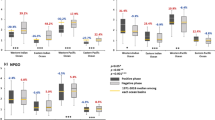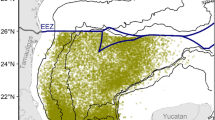Abstract
Nearly 70% of the world's annual tuna harvest, currently 3.2 million tonnes, comes from the Pacific Ocean. Skipjack tuna ( Katsuwonus pelamis ) dominate the catch. Although skipjack are distributed in the surface mixed layer throughout the equatorial and subtropical Pacific, catches are highest in the western equatorial Pacific warm pool, a region characterized by low primary productivity rates1 that has the warmest surface waters of the world's oceans (Fig. 1). Assessments of tuna stocks indicate that recent western Pacific skipjack catches approaching one million tonnes annually are sustainable2. The warm pool, which is fundamental to the El Niño Southern Oscillation (ENSO) and the Earth's climate in general3,4,5, must therefore also provide a habitat capable of supporting this highly productive tuna population. Here we show that apparent spatial shifts in the skipjack population are linked to large zonal displacements of the warm pool that occur during ENSO events5,6. This relationship can be used to predict (several months in advance) the region of highest skipjack abundance, within a fishing ground extending over 6,000 km along the Equator.

a, In the first half of 1989 (La Niña period). b, In the first half of 1992 (El Niño period). The effect of ENSO on the location of the warm pool (SST > 28–29 °C) and the distribution of skipjack catch is clearly evident.
This is a preview of subscription content, access via your institution
Access options
Subscribe to this journal
Receive 51 print issues and online access
$199.00 per year
only $3.90 per issue
Buy this article
- Purchase on Springer Link
- Instant access to full article PDF
Prices may be subject to local taxes which are calculated during checkout


Similar content being viewed by others
References
Longhurst, A., Sathyendranath, S., Platt, T. & Caverhill, C. An estimate of global primary production in the ocean from satellite radiometer data. J. Plankton Res. 17, 1245–1271 (1995).
Kleiber, P., Argue, A. W. & Kearney, R. E. Assessment of Pacific skipjack tuna ( Katsuwonus pelamis ) resources by estimating standing stock and components of population turnover from tagging data. Can. J. Fish. Aquat. Sci. 44, 1122–1134 (1987).
McPhaden, M. J. & Picaut, J. El Niño-Southern Oscillation displacements of the Western Equatorial Pacific warm pool. Science 50, 1385–1388 (1990).
Jin, F. F. Tropical ocean–atmosphere interaction, the Pacific cold tongue, and the El Niño–Southern Oscillation. Science 274, 76–78 (1996).
Picaut, J., Ioualalen, M., Menkes, C., Delcroix, T. & McPhaden, M. J. Mechanism of the zonal displacement of the Pacific warm pool: implications for ENSO. Science 274, 1486–1489 (1996).
Picaut, J. & Delcroix, T. Equatorial wave sequence associated with warm pool displacement during the 1986–1989 El Niño–La Niña. J. Geophys. Res. 100, 18393–18408 (1995).
Kuroda, Y. & McPhaden, M. J. Variability in the Western Equatorial Pacific Ocean during Japanese Pacific climate study cruises in 1989 and 1990. J. Geophys. Res. 98, 4747–4759 (1993).
Eldin, G., Rodier, M. & Radenac, M.-H. Physical and nutrient variability in the upper equatorial Pacific associated with westerly wind forcing and wave activity in October 1994. Deep Sea Res. (in the press).
Legeckis, R. Long waves in the eastern equatorial Pacific ocean: a view from a geostationary satellite. Science 197, 1179–1181 (1977).
Yamamoto, T. & Nishizawa, S. Small-scale zooplankton aggregations at the front of a Kuroshio warm-core ring. Deep Sea Res. 33, 1729–1740 (1986).
Yoder, J. A., Ackleson, S. G., Barber, R. T., Flament, P. & Balch, W. M. Aline in the sea. Nature 371, 689–692 (1994).
Power, J. H. Simulations of the effect of advective–diffusive processes on observations of plankton abundance and population rates. J. Plankton Res. 18, 1881–1896 (1996).
Flament, P., Kennan, S. C., Knox, R. A., Niiler, P. P. & Bernstein, R. L. The three-dimensional structure of an upper ocean vortex in the tropical Pacific ocean. Nature 383, 610–613 (1996).
Laurs, R. M., Fiedler, P. C. & Montgomery, D. R. Albacore tuna catch distributions relative to environmental features observed from satellites. Deep Sea Res. 31, 1085–1099 (1984).
Fiedler, P. C. & Bernard, H. J. Tuna aggregation and feeding near fronts observed in satellite imagery. Continent. Shelf Res. 7, 871–881 (1987).
Richards, L. J. & Schnute, J. T. An experimental and statistical approach to the question: is CPUE an index of abundance? Can. J. Fish. Aquat. Sci. 43, 1214–1227 (1986).
Chen, W. Y. Assessment of Southern Oscillation sea level pressure indices. Month. Weath. Rev. 110, 800–807 (1982).
Cane, M. A., Zebiak, S. E. & Dolan, S. C. Experimental forecasts of El Niño. Nature 321, 827–832 (1986).
Barnett, T. P. et al. On the prediction of the El Niño of 1986–87. Science 241, 192–196 (1988).
Chen, D., Zebiak, S., Busalacchi, A. J. & Cane, M. A. An improved procedure for El Niño forecasting: implications for predictability. Science 269, 1699–1702 (1995).
Chavez, F. P. & Barber, R. T. An estimate of new production in the equatorial Pacific. Deep Sea Res. 34, 1229–1243 (1987).
Sharp, G. D. & Dizon, A. E. (ed.) The Physiological Ecology of Tunas (Academic, San Diego, 1978).
Dragovitch, A. The food of skipjack and yellowfin tunas in the Atlantic ocean. Fish. Bull. US 70, 1087–1110 (1970).
Roger, C. & Grandperrin, R. Pelagic food webs in the tropical Pacific. Limnol. Oceanogr. 21, 731–735 (1976).
Roger, C. The plankton of the tropical western Indian ocean as a biomass indirectly supporting surface tunas (yellowfin, Thunnus albacares and skipjack, Katsuwonus pelamis ). Environ. Biol. Fish. 39, 161–172 (1994).
Vinogradov, M. E. in Analysis of Marine Ecosystems (ed. Longhurst, A. R.) (Academic, San Diego, 1981).
Hansen, D. V. & Swenson, M. S. Mixed layer circulation during EqPac and some thermochemical implications for the equatorial cold tongue. Deep Sea Res. 43, 707–724 (1996).
Piontkovski, S. A. & Williams, R. Multiscale variability of tropical ocean zooplankton biomass. ICES J. Mar. Sci. 52, 643–656 (1995).
Eckman, J. E. Modelling physical–biological coupling in the ocean: the U.S. GLOBEC Program. Deep Sea Res. 41, 1–5 (1994).
Hampton, J. Estimates of tag-reporting and tag-shedding rates in a large-scale tuna tagging experiments in the western tropical Pacific Ocean. Fish. Bull. US 95, 68–79 (1997).
Acknowledgements
We thank colleagues who provided data used in this study, particularly J. Joseph, R. Allen and M. Hinton for providing catch data for eastern Pacific tuna fisheries, and R. Grandperrin, J.-M. André and K. Bigelow for comments. This work was supported by the European Union-funded South Pacific Regional Tuna Resource Assessment and Monitoring Project of the Oceanic Fisheries Programme of the South Pacific Commission.
Author information
Authors and Affiliations
Author notes
Correspondence and requests for materials should be addressed to P.L.
Corresponding author
Rights and permissions
About this article
Cite this article
Lehodey, P., Bertignac, M., Hampton, J. et al. El Niño Southern Oscillation and tuna in the western Pacific. Nature 389, 715–718 (1997). https://doi.org/10.1038/39575
Received:
Accepted:
Issue Date:
DOI: https://doi.org/10.1038/39575
This article is cited by
-
Identification of Fishing State of Purse Seine Fishing Vessels Based on Multi-Indices
Journal of Ocean University of China (2023)
-
Effects of El Niño-Southern Oscillation (ENSO) on the reproduction of migratory fishes in a large South American reservoir
Hydrobiologia (2022)
-
Surface chlorophyll blooms in the Southern Bay of Bengal during the extreme positive Indian Ocean dipole
Climate Dynamics (2022)
-
Comparison of nominal and standardized catch per unit effort data in quantifying habitat suitability of skipjack tuna in the equatorial Pacific Ocean
Acta Oceanologica Sinica (2022)
-
Robust decrease in El Niño/Southern Oscillation amplitude under long-term warming
Nature Climate Change (2021)
Comments
By submitting a comment you agree to abide by our Terms and Community Guidelines. If you find something abusive or that does not comply with our terms or guidelines please flag it as inappropriate.



